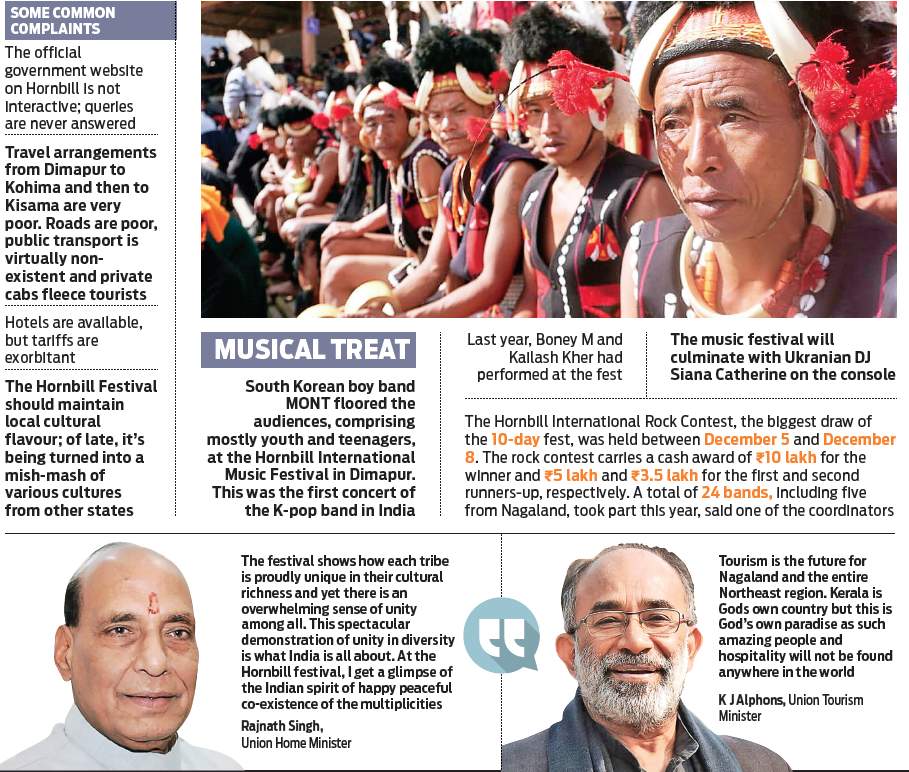A change in the composition of festival events got additional brickbats, especially from budget tourists.
By Prasanta Mazumdar
Source: The New Indian Express
It’s an annual cultural carnival in the picturesque Kohima hills that aims to showcase the rich heritage and culture of the Naga tribes. Over the years, Nagaland’s annual Hornbill Festival has gained global fame that attracts tourists from all corners of the world. But the colourful festival, it seems, is losing its lustre, thanks to infrastructure blues tourists face.
This year, the festival is getting flak over shoddy planning and the state’s crumbling infrastructure. Both domestic and foreign tourists have been complaining about bumpy roads and fleecing hotels and cabs. Worse, there’s nobody to address their problems and grievances. A change in the schedule of events led to more brickbats, particularly from budget tourists.
Conceived as a major event nearly two decades ago, replete with a tourist village in 2003, the necessary infrastructure or capacity-building never really took off. Hotels are known to have duped tourists, while transportation remains a headache.
“Hi, this is Justine and I am giving you some feedback on the Hornbill festival. …Information that is available about the festival for an independent traveller is actually very little information. You have a website for the festival. Nobody replies to emails. My husband, I and another foreigner come and spend money in your lovely region and you are not really making it easy for anybody,” a livid foreign tourist says in an audio which has gone viral.

“First time at the festival. Excellent show; loved every moment. Only felt that local transport to commute to the festival is tough. No taxis available,” Ayu Chakhroborti from Kolkata wrote in the visitors’ book.
“Festival is fantastic but very difficult to attend and enjoy the festival due to poor communication, i.e. bad condition of road…” wrote Somnath Gorain from West Bengal.
But some, like Guwahati-based journalist Karishma Hasnat, are willing to make allowances.
“The colours and vibrancy associated with Nagaland, the different tribes and their unique ways, the fun and festivities — everything is so alluring that anyone would like to come back despite the bad road conditions,” she says.“The fest indeed succeeded in showcasing the culture that the people of Nagaland take pride in,” concurs Lt Cdr Nikhil Fernandez.
Cornel Hinders from The Netherlands wrote two interesting lines: “India should leave Nagaland to the Nagas. It doesn’t belong to them”.
The travails for the increasing number of tourists begin as soon as they arrive in Dimapur, thanks to the roads. From there, the road to Kohima is still being converted into a four-lane, and tourists cannot escape the bumpy and dusty ride to the capital town. And in Kohima, hotels have arbitrarily hiked tariffs, while cab drivers charge as per their whims. Public transport to go to the festival site, Naga Heritage Village at Kisama, located some 12 km away, is abysmal at best. Hornbill appears to have become a festival for the rich.
Reacting to Justine’s charges, Nagaland’s Tourism department said it responds to every single email sent to its website www.tourismnagaland.com. But an email which this correspondent had sent to the website seeking information on the festival went unanswered.The tourism department also claimed that bus services were in place and a helicopter service was introduced at a subsidised rate.
‘Tourist Police’ were available all the time even beyond Kohima to drop tourists at their destinations as the festival was being held at different locations including Dimapur where music and bamboo carnival were held. “We regret our shortfalls but hope that all will look at the positive aspects and have a Happy Hornbill,” the department said.
Organised by Nagaland’s Tourism and Art & Culture Departments, the Hornbill Festival showcases a confluence of cultural displays under one roof and encourages inter-tribal interaction and promotes cultural heritage of Nagaland. It is named after hornbill which is part of the folklore of most Naga tribes.







 An orbiting message of peace
An orbiting message of peace What Does Your Face Say About Your Health?
What Does Your Face Say About Your Health? The last Konyak headhunters of Nagaland
The last Konyak headhunters of Nagaland The Top Viral YouTube Videos of 2017
The Top Viral YouTube Videos of 2017










Leave a Reply
Your email address will not be published. Required fields are marked (required)